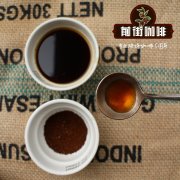Low temperature anaerobic fermentation process and Costa Rican herding process at Tarajul, Costa Rica

Professional coffee knowledge exchange more coffee bean information please follow the coffee workshop (Wechat official account cafe_style)
Introduction to low temperature anaerobic fermentation of Qianjie Coffee in Tarazhu Grand Shepherd Manor, Costa Rica
The Grand Shepherd Manor of Costa Rica (Finca La Pastora) has a history of more than 60 years and now has modern production and processing equipment. Minor Esquival Picado, the owner of the farm, is a very creative coffee grower who is happy to use a variety of innovative treatment methods and production models to truly achieve the sustainable development of coffee.
The manor is located in the Dota area of Tarazhu production area, with an elevation of 1700-2000 meters. The manor has a good ecological environment, including Poro, avocado, cedar, Dama and other shade trees, as well as fertile volcanic soil and abundant rainfall and other congenital factors provide excellent conditions for coffee cultivation. Excellent production level and superb processing technology make the manor enjoy a good reputation, but also have excellent results in professional competitions.
In the coffee treatment, a new low temperature anaerobic washing method was used to select only crimson mature coffee cherries. After floating and removing the peel, special active yeast was used and soaked in low temperature spring water at 6 degrees Celsius for 16-24 hours to ferment.
Generally speaking, what we mean by anaerobic is the anaerobic state, which means putting the coffee in a sealed container or fermenting with some substance. Fermentation can produce new by-products and unexpected flavors, but the process requires precise control of sugars, temperature, pressure, pH and time.
Before discussing fermentation, we need to understand the structure of coffee fruit. The sweetness of coffee fruit is mainly concentrated in fruit juice. Coffee fruit is the fruit of Rubiaceae shrubs, the mucus contains sugars and aromatic substances that bring its "flavor", and the concentration of sugar and these substances depends on the variety of coffee, fruit maturity, soil and other factors.
Fermentation is used in the process of removing mucus from coffee fruits in large quantities to obtain coffee seeds (that is, coffee beans). This anaerobic double card of the Grand Shepherd Manor in Costa Rica uses a new low-temperature anaerobic washing method, selecting only crimson ripe coffee cherries, floating and removing the peel using specially active yeast, and soaking in low-temperature spring water at 6 degrees Celsius for 16-24 hours to ferment. After fermentation, it was placed on the African drying bed for sun drying, and the stable and slow drying process lasted as long as 22 days.
Generally speaking, the process of anaerobic fermentation is easier to control, and the flavor will eventually be reflected in multi-layered and soft and rich acidity, and the washing process will help to prolong the fermentation time, resulting in softer texture, complex acidity and more refined flavor. this low-temperature anaerobic water wash at the Grand Shepherd Manor in Costa Rica will also show elegant citric acid, cherry and apple flavors with dark chocolate and brown spices.
Important Notice :
前街咖啡 FrontStreet Coffee has moved to new addredd:
FrontStreet Coffee Address: 315,Donghua East Road,GuangZhou
Tel:020 38364473
- Prev

Cryogenic anaerobic fermentation at Tarazhu Grand Shepherd Estate, Costa Rica: red kadura, yellow kadu
Professional coffee knowledge exchange More coffee bean information Please pay attention to coffee workshop (Weixin Official Accounts cafe_style) Front Street Coffee Costa Rica Tarrazu Dota Finca La Pastora Anaerobic Washed Costa Rica Tarrazu Dota Finca La Pastora Anaerobic Washed
- Next

Anaerobic Honey treatment of Santansan Grass Manor in Colombia
Professional coffee knowledge exchange more coffee bean information please follow Coffee Workshop (Wechat official account cafe_style) Front Street Coffee-Columbia Santansan Grass Manor anaerobic Honey treatment Rose Summer introduction Colombia Santansan Grass Manor anaerobic Honey treatment Rose Summer country: Colombia Colombia Origin: Santang Santander Manor: grass Manor La Pradera varieties: Rose Summer
Related
- Does Rose Summer choose Blue, Green or Red? Detailed explanation of Rose Summer Coffee plots and Classification in Panamanian Jade Manor
- What is the difference between the origin, producing area, processing plant, cooperative and manor of coffee beans?
- How fine does the espresso powder fit? how to grind the espresso?
- Sca coffee roasting degree color card coffee roasting degree 8 roasting color values what do you mean?
- The practice of lattes: how to make lattes at home
- Introduction to Indonesian Fine Coffee beans-- Java Coffee producing area of Indonesian Arabica Coffee
- How much will the flavor of light and medium roasted rose summer be expressed? What baking level is rose summer suitable for?
- Introduction to the characteristics of washing, sun-drying or wet-planing coffee commonly used in Mantenin, Indonesia
- Price characteristics of Arabica Coffee Bean Starbucks introduction to Manning Coffee Bean Taste producing area Variety Manor
- What is the authentic Yega flavor? What are the flavor characteristics of the really excellent Yejasuffi coffee beans?

